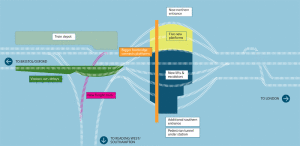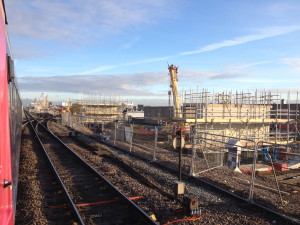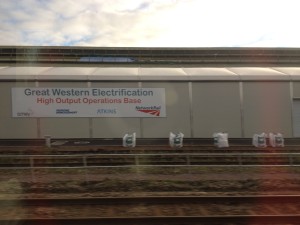An awards event in Bristol last Friday took me west of Reading on the Great Western Main Line for the first time in many months.
Most recent attention around Reading has concentrated on rebuilding the station. It’s an impressive project that has created a much bigger station (although it’s done little to combat the cold that pervades in winter). There’s plenty of work still to do; witness closed platforms, safety barriers and a collection of plant.
However, it’s now west of the station that should catch headlines today. Network Rail is creating grade-separated junctions to ease the flow of main line trains and allow freight trains to cross under to reach the GWML Relief Lines without creating disruption.
 A Network Rail diagram showing how new flyovers west of Reading station will ease traffic flows.
A Network Rail diagram showing how new flyovers west of Reading station will ease traffic flows.
I shouldn’t have been surprised at the progress NR has made over recent months. Since First Great Western vacated its old depot in Reading Triangle earlier this year, NR has been able to push forward with its viaducts, casting reinforced concrete pillars and craning spans into place. The line of pillars stretches westwards, with a gap for the West Curve to sneak past. They follow the route of the old Main Lines while wider track remodelling has allowed just enough tracks to cope with the parade of Great Western and CrossCountry trains, in addition to the many freight services.
Reading West viaduct under construction with the junction leading to West Curve on the left.
Elsewhere on the route west, NR has built a new depot at Swindon for its high-output electrification train that should soon be delivered. Eagle-eyed passengers can spot materials stores dotted along the line, with the most visible at Moreton. Those very sharp of eye will see mast foundations already in place.
Swindon’s high-output electrification depot stands ready to receive NR’s latest hi-tech machinery.
Through all this work, the train operators – chiefly First Great Western – must continue running and doubtless suffer the delays that come to trains in any project such as this. With long-distance performance already suffering, NR must work very hard to minimise the disruption and delays it causes the many thousands of passengers that use this key corridor. Time will tell whether the infrastructure is up to, or up for, this challenge.

